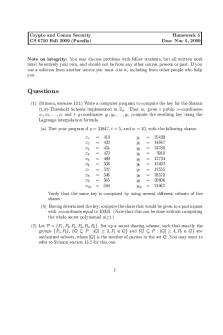Seminar assignments - Ebola worksheet PDF

| Title | Seminar assignments - Ebola worksheet |
|---|---|
| Course | Microbiology |
| Institution | Baylor University |
| Pages | 2 |
| File Size | 62.2 KB |
| File Type | |
| Total Downloads | 87 |
| Total Views | 203 |
Summary
Ebola Worksheet ...
Description
Ebola: The Plague Fighters 1. Define virulent: the severity of the disease 2. Location and dates of this outbreak reported in the video are: 1985; Kikwit, Zaire 3. What is the Kikwit handshake? Elbow to elbow 4. How was the disease diagnosed and confirmed? In a lab in Georgia 5. What is the etiology of this disease? Virus, scientific enigma 6. What type of virus is Ebola? (Structure and classification) Filovirus 7. Would you describe this as a common source epidemic or a propagated epidemic? Why? Propagated epidemic because it is contagious 8. Is this an example of commensalism, mutualism or parasitism? Parasitism 9. List two different symptoms of Ebola hemorrhagic Fever. Headache, fever, stomach pain, vomiting 10. List two different signs of Ebola hemorrhagic Fever. Red eyes, rash, internal/ external bleeding 11. Is this a communicable disease? Yes 12. Is this a contagious disease? Yes 13. Is Ebola hemorrhagic fever a sporadic disease, an endemic disease, a pandemic disease or an epidemic disease? Epidemic disease 14. Is this an acute disease, a chronic disease or a latent disease? Acute disease 15. Is there any evidence of “herd immunity”? Why or why not. No, because most infected die 16. Is this a local infection, systemic infection, focal infection or subclinical infection? Systematic infection 17. What is the incubation period for this disease? 2 to 21 days 18. How long is the course of the disease? Death comes within 10 days 19. What is/are the reservoirs of infection for this disease? Zootonic; animal host 20. How is this disease transmitted? Direct contact with blood and secretions; monkeys, it is airborne 21. Is this a nosocomial infection? No 22. Is this an emerging disease? Why or why not? Yes 23. How can the spread of this disease be contained? Quarantine 24. What specific measures were taken at the hospital to prevent the spread of this disease? Stinging bleach, burning used instruments and clothing in hospitals 25. What common practices in this village helped to spread the disease? Burials involving touching the bodies
26. Kikwit was a large rural village of 400,000 people. There were 315 cases of Ebola hemorrhagic fever reported and of these 250 people died. What is the mortality rate for this disease? 250/315 X 100= 79% 1 in 5 patients are still alive...
Similar Free PDFs

Seminar assignments
- 3 Pages

Seminar assignments
- 11 Pages

Seminar assignments - Assignment 15
- 11 Pages

Seminar assignments - Tax shield
- 1 Pages

Seminar assignments - Skew test
- 3 Pages

Seminar assignments ass1-14
- 2 Pages

Seminar assignments - everest report
- 15 Pages

Seminar assignments - Homework 5
- 1 Pages

Seminar assignments - report#1
- 3 Pages

Seminar assignments - And solutions
- 50 Pages

Seminar assignments - assignment 2
- 12 Pages

Seminar assignments Homework 14
- 3 Pages
Popular Institutions
- Tinajero National High School - Annex
- Politeknik Caltex Riau
- Yokohama City University
- SGT University
- University of Al-Qadisiyah
- Divine Word College of Vigan
- Techniek College Rotterdam
- Universidade de Santiago
- Universiti Teknologi MARA Cawangan Johor Kampus Pasir Gudang
- Poltekkes Kemenkes Yogyakarta
- Baguio City National High School
- Colegio san marcos
- preparatoria uno
- Centro de Bachillerato Tecnológico Industrial y de Servicios No. 107
- Dalian Maritime University
- Quang Trung Secondary School
- Colegio Tecnológico en Informática
- Corporación Regional de Educación Superior
- Grupo CEDVA
- Dar Al Uloom University
- Centro de Estudios Preuniversitarios de la Universidad Nacional de Ingeniería
- 上智大学
- Aakash International School, Nuna Majara
- San Felipe Neri Catholic School
- Kang Chiao International School - New Taipei City
- Misamis Occidental National High School
- Institución Educativa Escuela Normal Juan Ladrilleros
- Kolehiyo ng Pantukan
- Batanes State College
- Instituto Continental
- Sekolah Menengah Kejuruan Kesehatan Kaltara (Tarakan)
- Colegio de La Inmaculada Concepcion - Cebu



